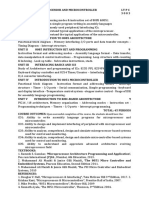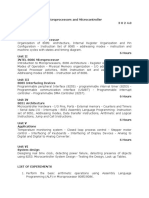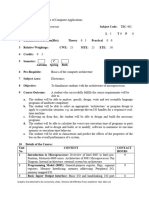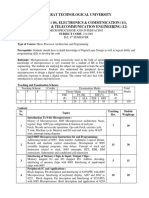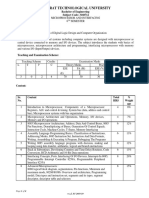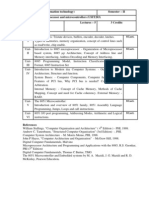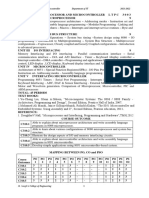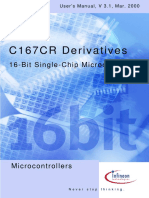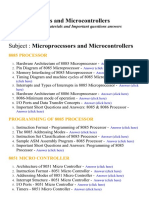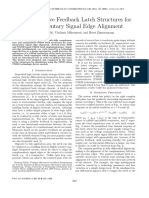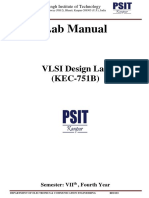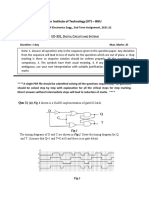Session 2024-25 (Even Semester) IILM University, Greater Noida
Subject Name:
School: School of Computer
Microprocessor and
Science & Engineering
Microcontroller
Subject Code: ES603
Department: Department of Year: 3rd
Computing and Security
L-T-P: 3-0-2
Machine Learning and Data
Science/ Computer Applications Semester: 6th
Pre-requisite Subject
Name and Code:
Digital Electronics
Course: Bachelor of
Computer Architecture &
Technology
Organization
Course Outcome
(At the end of the course, student Description
will be able understand)
Understand the basics concepts of microprocessors/microcontrollers
C01 and its programming.
Apply the concept of programming to communicate with
C02 microprocessor/microcontroller’s components/peripherals.
Apply the ease of interfacing to communicate with
C03 microprocessor/microcontroller and its components/peripherals.
Apply the mechanism of software and hardware part of
C04 microprocessor/microcontroller in the context of problem-solving.
Develop the microprocessor/microcontroller-based applications.
C05
Detailed Syllabus (Theory)
No. of
Unit No. Topics CO No. Proposed
Lectures
Introduction to Microprocessor: Microprocessor
architecture and its operations, Memory, Input & output
devices, the 8085 MPU- architecture, Pins and signals,
1 Logic devices for interfacing, Memory interfacing, 1 8
Interfacing output displays, Interfacing input devices,
Memory mapped I/O, Addressing Modes, Timing
Diagrams.
Basic Programming concepts: Data Transfer operations,
Arithmetic operations, Logic operations, Branch operation,
writing assembly language programs, Programming
2 techniques: looping, counting, and indexing. Additional 2 9
data transfer and 16-bit arithmetic instruction, Logic
operation: rotate, compare, counter and time delays, Stack
and Subroutines.
Page 1 of 3
� Session 2024-25 (Even Semester) IILM University, Greater Noida
Peripheral Devices: 8255 programmable peripheral
interface, 8253/8254programmable timer/counter, 8085
3 3 7
interrupts and 8259 programmable interrupt controller,
8237 DMA Controller, 8251 USART and RS232C.
Microprocessor 8086: Microprocessor 8086 pins and its
architecture, Bus interface unit, Execution unit, modes
(minimum and maximum), memory segmentation, flag
registers and their functions, instruction sets of 8086 (Data
4 4 9
Transfer, Arithmetic, Bit Manipulation, String, Program
Execution Transfer - Branch & Loop, Processor Control,
Iteration Control, and Interrupt Instructions), programming
of 8086.
8051 Microcontroller and Assembly programming:
Microcontrollers and Embedded Processors, Block
Diagram, PSW and Flag Bits, Register Banks and Stack,
Internal Memory Organization, IO Port Usage, Types of
5 Special Function Registers and their uses, Memory 5 9
Address Decoding, Addressing Modes, Data types and
Assembler directives, Arithmetic, logic instructions and
programs, Jump, loop and call instructions, IO port
programming.
Beyond Recent and Advance Applications of Microprocessors and
2
Syllabus Microcontrollers.
Text Books:
• Ramesh Gaonkar, “Microprocessor Architecture, Programming, and Applications with the 8085”,
6th Edition, Penram International Publication (India) Pvt. Ltd.,2013.
• D. V. Hall: Microprocessors Interfacing, TMH 3rd Edition.
• Mazidi Ali Muhammad, Gillispie Janice, and McKinlay Rolin D., “The 8051 Microcontroller and
Embedded Systems using Assembly and C”, Pearson, 2nd Edition, 2006.
Reference Book:
• Kenneth L. Short, “Microprocessors and programmed Logic”, 2nd Ed, Pearson Education Inc., 2003.
• Barry B. Brey, “The Intel Microprocessors, 8086/8088, 80186/80188, 80286, 80386, 80486,
Pentium, Pentium-Pro Processor, Pentium-II, Pentium-III, Pentium-IV, Architecture, Programming
& Interfacing”, Eighth Edition, Pearson Prentice Hall, 2009.
• Shah Satish, “8051 Microcontrollers MCS 51 Family and its variants”, Oxford, 2010.
Page 2 of 3
� Session 2024-25 (Even Semester) IILM University, Greater Noida
List of Practical
Practical No. Practical
1 Write a program using 8085/8086 Microprocessor for data transfer from register to
register and register to memory.
2 Write a program using 8085/8086 Microprocessor for Decimal, Hexadecimal addition of
two Numbers.
3 Write a program using 8085/8086 Microprocessor for Decimal, Hexadecimal subtraction
of two Numbers
4 Write a program using 8085/8086 Microprocessor for addition and subtraction of two
BCD numbers.
5 To perform multiplication of two 8-bit numbers using 8085/8086.
6 To perform division of two 8-bit numbers using 8085/8086.
7 To find the largest number in an array of data using 8085/8086 instructions set.
8 To find the smallest number in an array of data using 8085/8086 instructions set.
9 To write a program using 8085/8086 to arrange an array of data in ascending order.
10 To write a program using 8085/8086 to arrange an array of data in descending order.
11 To convert given Hexadecimal number into its equivalent ASCII number and vice versa
using 8085/8086 instructions set
12 To convert given Hexadecimal number into its equivalent BCD number and vice versa
using 8085/8086 instructions set.
13 To interface 8255 PPI and verify the operation of input and output modes using
8085/8086.
14 To interface 8253 programmable interval timer and verify the operation of 8253 in six
different modes using 8085/8086.
15 To write a program to initiate 8251 and to check the transmission and reception of
character using 8085/8086.
16 Serial communication between two 8085/8086 through RS-232 C port.
17 Write a program of Flashing LED connected to port 1 of the 8051 Micro Controller.
18 Write a program to generate 10 kHz square wave using 8051.
19 Write a program to show the use of INT0 and INT1 of 8051.
20 Write a program for temperature & to display on intelligent LCD display.
Page 3 of 3














